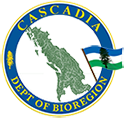STICK
[stik] — noun, adjective
Meaning: Tree, stick, timber, pole, rod, log, wood, wooden.
Origin: English stick
The “Quinault Lake Redcedar” is currently the largest western red cedar in the world. At 532 meters (174 feet) tall, and 6 meters (19.5 feet) around, it is estimated to containing 500 cu. meters (17,650 cubic feet) of wood.
Away from an “kah hiyu apple stick mitlite” (orchard), deep in the “stick illahee” (forest) one could easily find both “mitwhit stick” (a standing tree) and “whim stick” (a fallen tree), as well as the occasional “koko stick” (wood-pecker), especially if one was operating from a “stick house” (logging camp) to collect “piah stick” (firewood; fuel) when they went out to “mamook stick” (cut wood; logging).
Besides serving as a word for “tree”, the word ‘stick’ also features in the words for parts of trees, such as “stick yaka lamah” (tree limb), “stick keekwullie kopa illahee” (root), and “lamah” or “lamah kopa stick” (tree knot), as well as parts of other plants, “chuck kopa stick” (sap), “needle kopa stick” (thorn), and “stick kahkwa lope” (ivy), and “stick kahkwa lope” (vine).
The word ‘stick’ also lent itself to the name of several types of trees; “eena stick” (beaver wood) was the name for the willow, while “kull stick” (hardwood) was given to the oak, though on the Columbia River it was referred to as “kahnaway stick” (acorn tree).
Occasionally one could tell of a tree’s primary use by the name given it; “lagome stick” or “goom stick” (pitch-wood) was the name given the pitch-pine (Pinus rigida), but could also be used to refer to a number of pine, fir, or spruce species. Similarly, the name “isick stick” (paddle-wood; oar-wood) was given to a number of trees, including the vine maple (Acer circinatum), red alder (Alnus rubra), and the Oregon ash (Fraxinus latifolia).
The red cedar (Thuja plicata) seemed to have two names; “canim stick” (canoe tree) indicated its value in making quality canoes, and “kalakwahtie stick” (skirt tree) due to the fact that women of the First Nations often wore a skirt made from strands of the inner bark once it has been pounded soft and pliable. Even the colorfully named “chittam stick” (shit tree) was insightful, for it was given to the cascara (Rhamnus purshiana), whose “stick skin” (bark) is a potent laxative.
The “moola stick” (mill tree; factory tree) likely referred to the Douglas fir (Pseudotsuga menziesii) as it was a versatile timber tree, sought for its relatively dense wood is used to produce large timber beams, boards, and railroad ties. Many of these trees would be processed at a “stick moola” (saw-mill), where some of the wood might end up as “kullagh stick” (fence rails).
The word had other meanings as well; an “ikt stick” (a yard measure) and “stick shoes” (boots) were important to surveyors. One should remember that a “stick ship” (sailing ship) should not be confused with a “ship stick” (a mast), though sometimes “mitwhit stick” was used for this sort of structure, and a notable part of the name for a “mokst stick ship” (schooner).
The Nooksack Giant was a Coast Douglas-fir (Pseudotsuga menziesii var. menziesii) that grew at Loop’s Ranch (now Alpenglow Farm) in Maple Falls in Washington State. It was felled in the 1890s. The tree was measured with a tape after felling at 142 meters (465 feet) tall, and 10 meters (34 feet) in circumference. It produced more than 96,000 board feet of lumber. The New York Times regarded the tree in a March 7, 1897 issue as the “most magnificent fir tree ever beheld by human eyes” and called its destruction a “truly pitiable tale” and a “crime”. The Morning Times of February 28, 1897 claimed that the wood, sawed into one-inch strips, would reach from “Whatcom [the tree’s location] to China”.
Everyday wooden tools featured the word, including “pish stick” (fishing rod), “moosmoos stick” (goad), and “tzum stick” (pen; pencil), as well as native items such as a “stick seeowist” (mask), “stick kalitan” (arrow), and “stick kalitan lesak” (arrow quiver).
Some have suggested the North American phrase “out in the sticks” may have originated in Chinook Jargon usages, adopted by Klondike-era travelers, and transmitted to other parts of the continent.





Post a comment